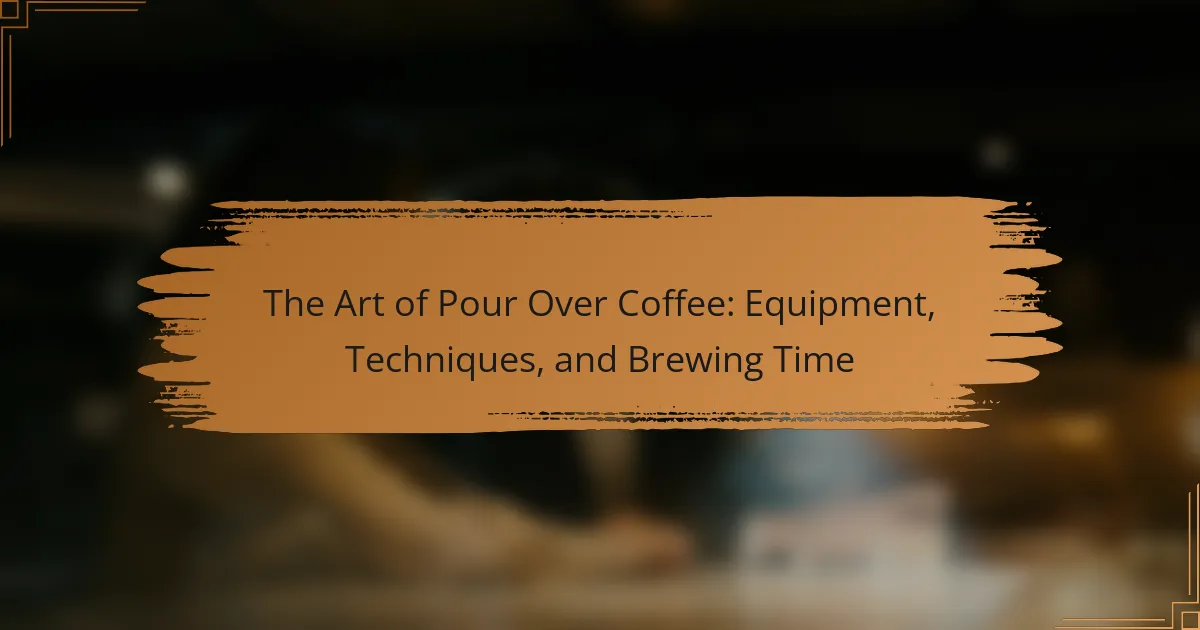
What are the key brewing methods for espresso?
The key brewing methods for espresso include the traditional espresso machine, stovetop moka pot, and AeroPress. The traditional espresso machine uses high pressure to force hot water through finely-ground coffee. This method typically produces a rich crema and concentrated flavor. The stovetop moka pot brews coffee by boiling water in the lower chamber, which then forces steam through the coffee grounds. This method creates a strong, espresso-like coffee but lacks the crema. The AeroPress uses air pressure to push hot water through coffee, allowing for a quick brew time and versatility in flavor profiles. Each method varies in equipment and technique, impacting the final taste and texture of the espresso.
How does each brewing method impact espresso flavor?
Different brewing methods impact espresso flavor by altering extraction time, pressure, and water temperature. The traditional espresso machine uses high pressure and short extraction time, resulting in a rich, concentrated flavor. A pour-over method allows for a longer extraction, often producing a brighter and more nuanced taste. French press brewing, while not typical for espresso, can yield a heavier body and more pronounced oils, affecting overall flavor. The AeroPress combines pressure and immersion, leading to a smooth and clean profile. Each method’s unique parameters influence the solubility of coffee compounds, thus shaping the final flavor profile.
What are the characteristics of espresso brewed using a traditional espresso machine?
Espresso brewed using a traditional espresso machine has a rich, concentrated flavor. It typically features a thick crema on top, contributing to its texture. The brewing process involves forcing hot water through finely-ground coffee at high pressure. This results in a bold and intense taste profile. Traditional machines often allow for precise temperature control, enhancing flavor extraction. The ideal brewing time ranges from 25 to 30 seconds. Espresso usually contains about 1 to 2 ounces per serving. It also has a higher caffeine concentration compared to regular coffee. These characteristics make traditional espresso distinct and sought after by coffee enthusiasts.
How does the French press method alter the espresso profile?
The French press method alters the espresso profile by changing the extraction process and flavor characteristics. Unlike espresso, which uses high pressure to extract flavors quickly, the French press relies on steeping coffee grounds in hot water. This results in a different balance of oils and solids in the final brew.
The French press allows for longer extraction times, leading to a fuller body and more pronounced flavors. It often emphasizes earthy and robust notes, while espresso tends to highlight acidity and sweetness. The lack of a paper filter in the French press retains more oils, contributing to a richer mouthfeel.
Research indicates that brewing methods significantly impact flavor profiles. A study published in the Journal of Food Science found that steeping time and method influence the aromatic compounds in coffee. Thus, the French press method distinctly alters the espresso profile, producing a unique flavor experience.
What unique flavors does the Aeropress bring to espresso?
The Aeropress brings unique flavors to espresso by emphasizing clarity and brightness. This method allows for a wide range of flavor profiles, from fruity notes to chocolate undertones. The immersion brewing technique extracts oils and soluble compounds effectively. This results in a full-bodied cup with a smooth texture. The variable brew time and water temperature enable customization of flavor intensity. Users can experiment with different coffee beans to enhance specific flavor notes. The Aeropress also reduces bitterness compared to traditional espresso methods. This creates a balanced cup that highlights the coffee’s natural characteristics.
What equipment is essential for brewing espresso?
The essential equipment for brewing espresso includes an espresso machine, a coffee grinder, and a tamper. An espresso machine is necessary to generate the high pressure required for brewing. A quality coffee grinder ensures uniform particle size for optimal extraction. A tamper is used to compress the coffee grounds evenly in the portafilter. These tools are fundamental for achieving the rich flavor and crema characteristic of espresso.
What types of espresso machines are available on the market?
There are several types of espresso machines available on the market. These include manual espresso machines, semi-automatic machines, automatic machines, and super-automatic machines. Manual espresso machines require the user to control the entire brewing process. Semi-automatic machines automate some functions while allowing user control over others. Automatic machines handle the brewing process more independently. Super-automatic machines grind, brew, and clean themselves with minimal user intervention. Each type offers different levels of control and convenience for espresso preparation.
How do grinders affect the quality of espresso?
Grinders significantly affect the quality of espresso by influencing grind size and consistency. The grind size determines the extraction rate of coffee solubles during brewing. Finer grinds increase surface area, leading to faster extraction and potentially over-extraction if not monitored. Conversely, coarser grinds slow extraction, which can result in under-extraction and a sour taste. Consistency in grind size is crucial for uniform extraction. Inconsistent grinds lead to uneven extraction, creating a mix of bitter and sour flavors. High-quality grinders provide precision and uniformity, enhancing the overall espresso flavor profile. A study by the Specialty Coffee Association indicates that grind consistency can improve espresso quality by up to 30%.
What accessories are important for a successful espresso brewing setup?
A successful espresso brewing setup requires several essential accessories. A high-quality espresso machine is fundamental for consistent extraction. A burr grinder is necessary for achieving the right grind size, which impacts flavor. A tamper ensures even compression of the coffee grounds for optimal extraction. A scale allows for precise measurement of coffee and water, ensuring consistency. A milk frother is important for creating microfoam if making lattes or cappuccinos. A shot glass or demitasse cup is needed to catch the espresso as it brews. Lastly, a cleaning brush helps maintain the equipment, ensuring longevity and performance. These accessories collectively contribute to a better espresso experience.

What are the different flavor profiles of espresso?
Espresso has a variety of flavor profiles that can be categorized into distinct groups. Common profiles include fruity, nutty, chocolatey, floral, and spicy. Fruity flavors often exhibit notes of berries, citrus, or stone fruits. Nutty profiles may present tastes reminiscent of almonds or hazelnuts. Chocolatey flavors can range from dark chocolate to milk chocolate tones. Floral notes often include hints of jasmine or lavender. Spicy profiles may feature flavors like cinnamon or clove. The specific flavor profile of an espresso depends on factors such as the coffee bean origin, roast level, and brewing technique. For example, beans from Ethiopia often have fruity and floral notes, while Brazilian beans may lean towards chocolatey and nutty flavors.
How do brewing techniques influence espresso taste?
Brewing techniques significantly influence espresso taste by affecting extraction levels and flavor profiles. Different methods, such as pressure, temperature, and time, alter the solubility of coffee compounds. For instance, using higher pressure typically results in a richer crema and a more intense flavor. Conversely, lower pressure may yield a lighter taste with less body.
Temperature also plays a crucial role. Higher temperatures can extract more oils and acids, leading to a bolder flavor. However, excessive heat can cause bitterness. The brew time is another critical factor. Longer extraction times can enhance sweetness but may also introduce undesirable bitterness if overdone.
Research indicates that optimal brewing parameters vary by coffee bean and roast level. For example, a study published in the Journal of Food Science found that varying extraction times from 25 to 30 seconds can significantly change the sensory profile of espresso. This demonstrates that brewing techniques are essential for achieving desired flavor outcomes in espresso.
What flavor notes are commonly found in espresso?
Espresso commonly features flavor notes of chocolate, caramel, and nuts. These notes arise from the roasting process and the coffee bean origin. Fruity and floral undertones can also be present, depending on the bean variety. The balance of acidity and sweetness is vital in espresso flavor profiles. Dark roasted beans often yield deeper, richer flavors, while lighter roasts can showcase more brightness and complexity. The extraction time during brewing influences these flavor notes significantly. A well-extracted espresso typically highlights these characteristics effectively.
How does water temperature affect flavor extraction in espresso?
Water temperature significantly influences flavor extraction in espresso. Higher temperatures, typically between 195°F and 205°F, enhance the solubility of coffee compounds. This leads to a richer extraction of oils, acids, and sugars. Conversely, lower temperatures can result in under-extraction. This may yield a sour or weak flavor profile. Research indicates that optimal extraction occurs around 200°F. Studies show that deviations from this range can alter the balance of flavors. For instance, temperatures above 205°F can lead to bitterness. Therefore, precise temperature control is crucial for achieving desired flavor profiles in espresso.
What role does grind size play in espresso flavor?
Grind size significantly influences espresso flavor. Finer grind sizes increase extraction rate, leading to more intense flavors. Coarser grinds result in under-extraction, producing a sour taste. Consistent grind size ensures uniform extraction, enhancing balance in flavor profiles. Optimal grind size for espresso typically ranges between 200 and 400 microns. Studies show that varying grind sizes can alter the concentration of soluble compounds. For example, finer grinds extract oils and acids more effectively. This results in a richer, fuller-bodied espresso. Conversely, uneven grind sizes can lead to bitter or watery flavors. Thus, grind size is crucial for achieving the desired espresso taste.
How does a finer grind impact espresso extraction?
A finer grind increases the surface area of coffee particles, enhancing espresso extraction. This results in a quicker infusion of flavors and compounds. The extraction process becomes more efficient due to the increased contact between water and coffee. Consequently, a finer grind can lead to a richer and more intense flavor profile. However, it also risks over-extraction if brewed for too long. Over-extraction can cause bitterness and undesirable flavors. The ideal grind size balances extraction time and flavor, typically requiring adjustments based on the espresso machine used. Studies show that optimal grind sizes vary between 200 to 800 microns for espresso preparation.
What are the effects of a coarser grind on flavor?
A coarser grind affects flavor by producing a milder taste in espresso. This grind size allows for faster extraction during brewing. Faster extraction reduces the intensity of flavors. Coarse grinds result in less bitterness. They also highlight sweeter and fruity notes in coffee. Studies show that grind size significantly influences flavor profiles. Research indicates that a coarser grind leads to a more balanced cup. This balance can enhance the overall drinking experience.

How can one optimize their espresso brewing process?
To optimize the espresso brewing process, one should focus on grind size, water temperature, extraction time, and pressure. A fine grind size increases the surface area, allowing for better extraction. The ideal water temperature ranges from 195°F to 205°F. Maintaining this temperature ensures optimal flavor extraction from the coffee grounds. The extraction time should be between 25 to 30 seconds to achieve a balanced shot. Lastly, the brewing pressure should be around 9 bars, which is standard for espresso machines. Research supports that these parameters significantly influence the flavor profile and quality of the espresso shot.
What are best practices for brewing espresso at home?
To brew espresso at home effectively, start with fresh, high-quality coffee beans. Use a burr grinder to achieve a consistent grind size, ideally around 18-20 grams for a double shot. Preheat your espresso machine and ensure it reaches optimal brewing temperature, typically between 190°F and 205°F. Use filtered water to avoid impurities that can affect taste. Pack the coffee evenly in the portafilter, applying firm and even pressure. Lock the portafilter into the machine securely. Brew for 25-30 seconds to extract the perfect shot. Monitor the extraction time and adjust grind size or dose as needed for consistency. Regularly clean your equipment to maintain flavor quality and performance.
How can one troubleshoot common espresso brewing issues?
To troubleshoot common espresso brewing issues, first identify the problem. If the espresso is sour, check the grind size; it may be too coarse. A fine grind can help balance acidity. If the shot takes too long, the grind may be too fine. Adjusting the grind can improve extraction time. If the crema is lacking, ensure fresh coffee beans are used. Stale beans can diminish crema quality. If the espresso is bitter, consider the extraction time; it might be over-extracted. A shorter brew time can reduce bitterness. Water temperature also affects flavor; it should be between 195°F and 205°F. Lastly, clean the espresso machine regularly. Build-up can affect taste and consistency.
What tips can enhance the espresso experience for beginners?
To enhance the espresso experience for beginners, focus on quality equipment and technique. Invest in a good espresso machine and a burr grinder. Freshly ground coffee is essential for optimal flavor. Use high-quality, fresh coffee beans, preferably roasted within the last two weeks. Measure coffee and water accurately for consistency. A standard ratio is 1:2, coffee to water. Preheat the espresso machine and cups to maintain temperature. Experiment with grind size and tamping pressure to find the ideal extraction. Aim for a brewing time of 25 to 30 seconds for a balanced shot. These practices lead to better espresso quality and enjoyment.
What resources are available for learning more about espresso brewing?
Books on espresso brewing include “The Professional Barista’s Handbook” by Scott Rao and “Espresso Vivace” by David Schomer. Online platforms such as YouTube offer tutorials from experienced baristas. Websites like Home-Barista.com provide forums and articles on espresso techniques. Coffee schools and workshops often teach espresso brewing in hands-on environments. Specialty coffee shops sometimes host classes for the public. These resources collectively enhance knowledge and skills in espresso brewing.
How can online communities assist in improving espresso skills?
Online communities can significantly enhance espresso skills through shared knowledge and resources. Members often exchange tips on brewing techniques and equipment. They provide feedback on individual espresso shots, helping users refine their methods. Many communities offer tutorials and video demonstrations for visual learners. Participants can ask specific questions and receive prompt responses from experienced baristas. Additionally, online forums host discussions on flavor profiles and bean selection, broadening understanding. Engaging with a community fosters motivation and accountability for practice. Research indicates that collaborative learning environments improve skill acquisition and retention, making online communities a valuable resource for espresso enthusiasts.
What books are recommended for mastering espresso techniques?
“Espresso Vivace: Espresso and the Art of Coffee” by David Schomer is highly recommended for mastering espresso techniques. This book covers the science and art behind espresso brewing. It provides detailed insights into espresso preparation and extraction methods. Another excellent resource is “The Professional Barista’s Handbook” by Scott Rao. This book offers practical guidance on espresso techniques and equipment. It includes tips for both beginners and experienced baristas. Lastly, “Coffee: A Comprehensive Guide to the Bean, the Beverage, and the Industry” by Robert W. Thurston is also beneficial. This book discusses various brewing methods, including espresso, and explores flavor profiles. Each of these books provides valuable knowledge for anyone looking to master espresso techniques.
The main entity of this article is espresso brewing methods, which encompass various techniques, equipment, and flavor profiles. Key brewing methods include traditional espresso machines, stovetop moka pots, and AeroPress, each affecting flavor through different extraction processes. The article discusses how factors like grind size, water temperature, and brewing time influence the taste and quality of espresso. Additionally, it covers essential equipment and accessories for home brewing, troubleshooting common issues, and resources for further learning, providing a comprehensive overview for coffee enthusiasts seeking to optimize their espresso experience.



